Congratulations! You’ve just bought a whole house water filter system. You’re excited to get the system up and running – but there’s just one thing that stands between you and a clean, filtered water supply:
Installation.
The manufacturer’s website says it’s easy to install their whole house water filtration system, but just how true is that? Will you be able to install the filter yourself? Or will you need to call a professional?
The installation process is unique for each of the different whole house water filtration systems on the market, and you should definitely check out your user manual when it arrives.
But in the meantime, this installation guide will give you a better understanding of how to install a whole house water filtration system, and whether it’s something you’ll be capable of doing.
Let’s begin.
Table of Contents
📖 Installation Diagram
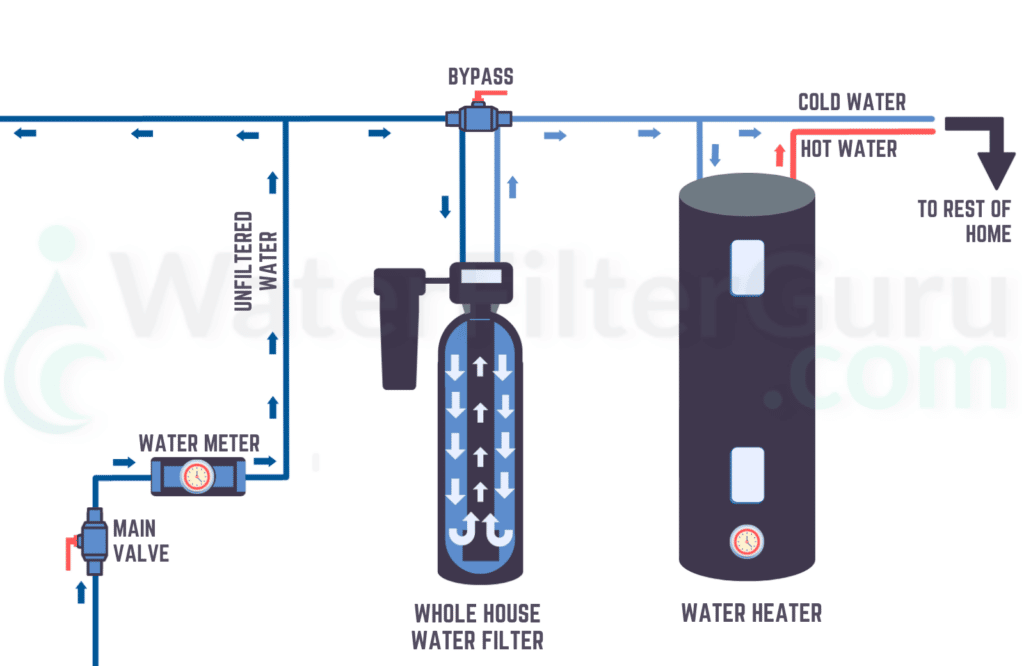
🔧 Installing a Whole House Water Filter: Step-By-Step Process
Here, we’ll take you through the steps involved in installing most whole house filtration systems.
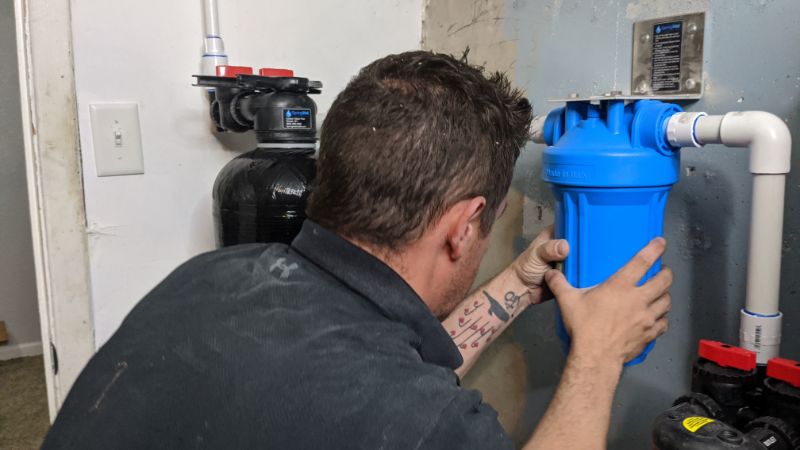
You Will Need:
Tools
- Pipe cutter
- Drill and drill bits
- Screwdriver
- Adjustable wrench
- Bucket
Parts
- Filtration system & included components
- A mounting bracket (usually included with the system)
- Push fittings and tubing
- Shut-off valve
- Bypass valve (optional)
- Plumber’s tape
Step 1: Choose the Location
Before you install a whole house filter at your water supply, you need to think carefully about the installation location.
The purpose of a whole home filter is to provide your entire water supply, including your hot water heater, with filtered water. So, you need to choose a location as close as possible to your water pipe’s entry point into your home, upstream of your water heater.
Your chosen location should have plenty of space. You need to be able to comfortably install the system, and easily access the filter housings or tanks when it’s time to replace the filters or media.
If you’re installing a filter for a home with a private well, make sure the filter is installed after the pressure tank.
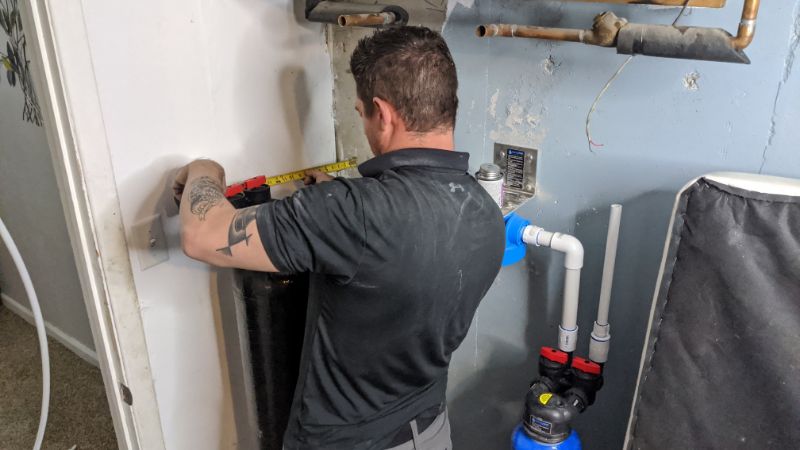
Indoor vs Outdoor Installation
Ideally, entire house filters should be installed indoors. If you can avoid installing the unit outside, do it. But if you don’t have enough space inside your home to install the system at your main supply, you can consider an outdoor installation.
Most water systems need to be protected by special weatherproof casings to prevent their plastic fittings and components from frost or sunlight damage. You’ll need to buy one of these casings, or build your own protective cover, to keep the filter working at its best. Remember, warranties don’t cover weather damage!
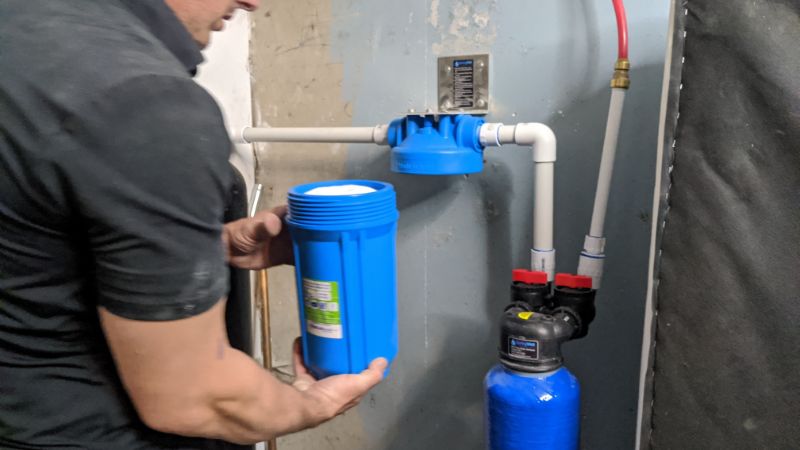
Step 2: Install the Filter
Once you’ve chosen your location on your main water line, you can get started with a do-it-yourself installation.
Here’s the step-by-step process to follow:
- Shut off the water: Shut off the water supply into your home, and open all your faucets to drain water and release trapped air from the pipes
- Cut into the main water line: Use a pipe cutter or a similar tool to cut into your main water line, removing a big enough section to fit the filter housing. Hold a bucket underneath the water line to catch any remaining water in the pipe
- Sand the pipe: Place the cut section of the pipe to the side and sand both cut ends of the pipe, then pick out any installation debris from the inside of the pipe
- Install shutoff valves: Install a shutoff valve on either side of the unit. This means that you can easily shut off water leading to and from the unit during maintenance, or in response to an emergency
- Install bypass: Consider installing a bypass valve alongside the shut off valve. Some units come with an included valve, but in most cases, you’ll need to pay extra for one. Bypass valves give you access to water even while the filter is out of use
- Install pressure gauge: Also consider installing a pressure gauge. Pressure gauges allow you to monitor the ingoing and outgoing water pressure around the unit, which is helpful for knowing when to change the filters
- Install the wall mount: Attach the wall mount to your wall (if your filter comes with one)
- Mount the unit: Install the filer, making sure the “in” and “out” ports are facing the right way. Use flex piping to attach the filter to your water line, and use push fittings and adaptors if your pipe size is too small or big for the unit’s plumbing connections. Secure the threaded ends with plumber’s or Teflon tape, preventing leaks
- Avoid over-tightening: You need a secure connection, but you shouldn’t overtighten the push fittings, as this could cause leaks
- Clean the unit: Rinse the inside of the filter housing or wipe down with a damp cloth to remove debris. Clean and grease the o-rings. Flush the filters in tap water according to the manufacturer’s instructions (if necessary)
- Turn on the water: Turn on your water supply so that water flows back into your pipes. Check the unit for leaks, and check for normal operation. If you need to do anything else to properly activate the filtering cartridges, do it now. Use more plumber’s tape or tighten the fittings if you notice any escaping water
- Install copper wire: If you have an older house, it may use your water pipes to ground your electrical system. In this case, make sure the ground stays intact by adding a copper wire (or jumper cable) that spans from one side of the new filter to the other
- Check water pressure: Monitor your flow of water from the nearest faucet. When your water pressure has been restored, turn off all your faucets
Step 3: Check Your Tap Water Quality (Optional)
If you want to check that your POE filter is working as it should, consider testing your water supply.
If you’ve bought a city water unit, test your filtered city water to find out how much chlorine and lead it contains, and compare this to the contaminant levels on your Water Quality Report. This will tell you how effectively the filtration unit is working. You can either pay for a private laboratory test or buy an at-home testing kit.

For well water, test for the contaminants that your unit targets (usually iron, manganese, and sulfur). Again, private testing and home testing kits are both available. You should test your water before and after installing the unit, so you know exactly how effective it is.
Remember, different filtration systems have different installation instructions. Before you get started, check that you have the right tools for your DIY project, and visit your local hardware store if you need to pick up some extra parts. It’s better to do this before you start the installation process, so that you’re prepared with everything you need.
Make sure to read your user manual carefully to learn exactly how your water system should be installed. Follow the installation steps closely and contact the manufacturer if you’re unsure.
Related Content
- The Best Whole Home Water Filtration Systems Reviewed for 2025
- Top rated sediment filters for your whole house water system
- Do whole house water filters reduce water pressure?
- Water filtration system for home cost: The 2025 Guide
- How to diagnose a whole house water filter leaking
⚖️ DIY vs Professional Installation
If you consider yourself a handy person, you should be able to follow manufacturer instructions and install a whole house water filter yourself.
With that said, making a mistake could lead to expensive damage to your plumbing, so you should think carefully about your ability to follow instructions and your plumbing knowledge.
For some people, the cost of a professional, proper installation is worth it for the peace of mind that they’re enlisting an expert to fit the system for them.
Read customer reviews if you’re planning to save money with a DIY installation. You’ll learn from a customer’s perspective exactly how challenging it is to install the system, and gauge whether you’ll be capable of installing the system yourself.
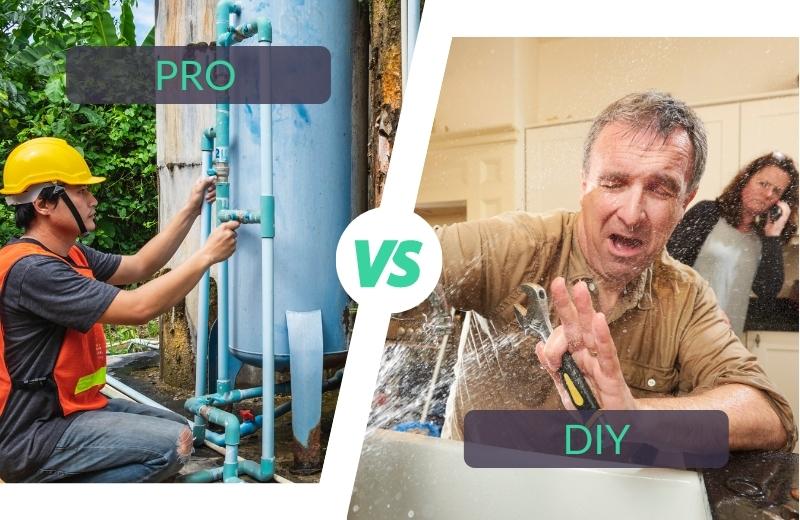
💬 Whole House Water Filter Installation FAQ
Got any burning questions about installing a whole house water filter system? You’ll probably find them in this FAQ section.
How much does it cost to install a whole house water filter?
That depends on whether you plan to install a whole house water filter yourself, or whether you plan to pay a professional to do it.
If you install the filter yourself, the cost of installation will be $0-$30, depending on whether or not you need to buy additional tools or parts for the job.
The cost of a professional installation is about $200. Some plumbers charge a flat fee for installing a whole house water filter system, while others charge by the hour.
Does a whole house water filter increase home value?
Yes. A whole house filter system provides a cleaner water supply to a property, so it can add value to your home.
However, we wouldn’t suggest installing a whole house filtration system for the sole purpose of selling your home. Keep in mind that some people won’t want to deal with the hassle of maintaining a filtration system, which could reduce your pool of interested buyers.
Where should a sediment filter be placed?
A sediment filter should be installed before any other water treatment unit in your home. This protects these systems from clogging or damage from sediment.
So, for instance, you would install a sediment filter as close to your home’s point of entry as possible, then install a water filter system downstream along the water pipe, to ensure sediment was removed from the water before it reached the filter.
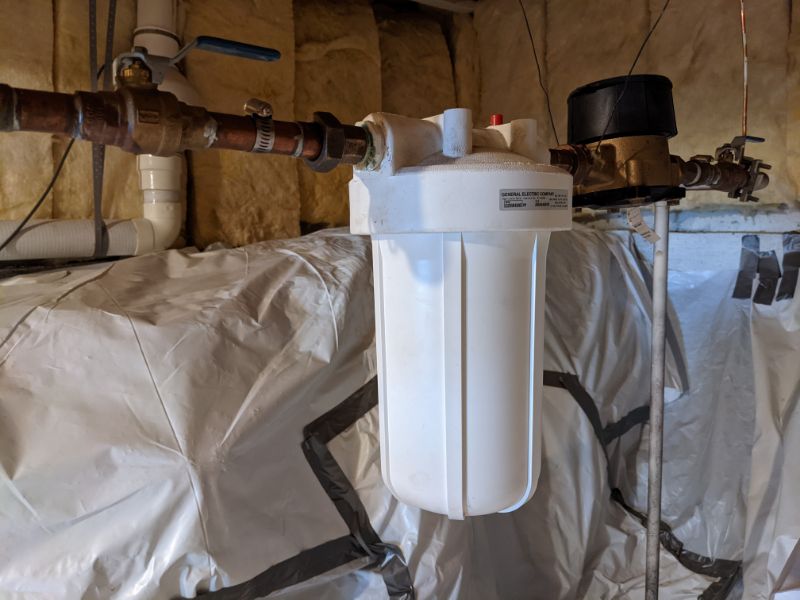
Does the water filter go before or after softener?
Typically, a water filter system should be installed before a water softener. This protects the softener from chlorine, iron, or other contaminants, which could damage the softening resin.
However, if you have very hard but only mildly contaminated water, you may need to install your water softener before your water filter, to protect the filter media from hardness minerals.
What order do water filters go in?
This entirely depends on the type of system you’re using.
For a traditional cartridge-based filter system, the order of water filters is as follows:
- Sediment filter
- Activated carbon filter
- Additional filters, such as GAC, zinc, or KDF
Some specialist filters include stages such as UV disinfection, a reverse osmosis membrane, and a remineralization filter. UV disinfection and remineralization are usually the final stages in a filter, while reverse osmosis membranes are typically the third stage along.
Tank-based systems usually have a single tank containing media and a sediment filter. The sediment filter goes first, and the tank follows.
Where should a whole house water filter be installed?
A whole house filter should be installed at your main water supply before your water heater. This means that your entire home’s appliances, including your water heater, have access to clean, filtered water.
Find out where your water pipe enters your home, then use the information in our guide above to choose the right spot for installing the system.
Can I install my own whole house water filter?
Yes, you can – and many people do! DIY installing your whole house filter is cheaper than hiring a professional, and manufacturers are getting better at providing instructions that anyone can follow. If you have basic DIY and plumbing knowledge, you should be fine to install the system yourself.
How long does it take to install a whole house water filter?
It takes approximately two to four hours for a professional plumber or handyman to install a whole house water filter. Depending on your skill in the plumbing department, the installation process could take slightly longer; up to six hours.
